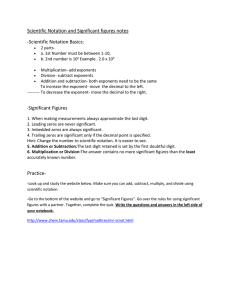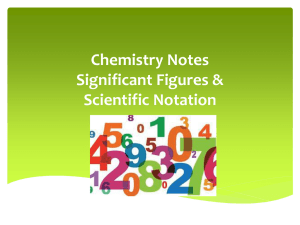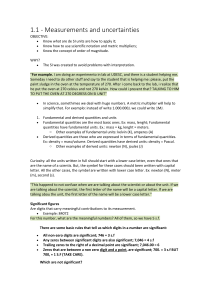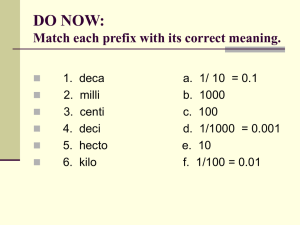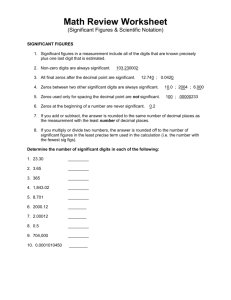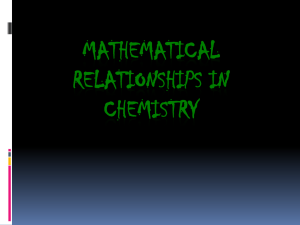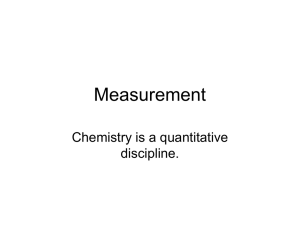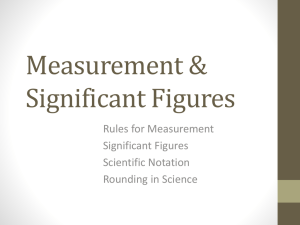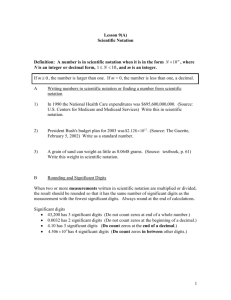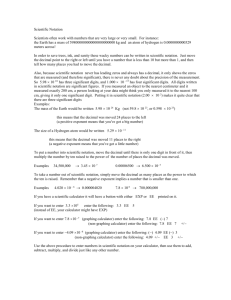Scientific Measurement - Madison County Schools
advertisement
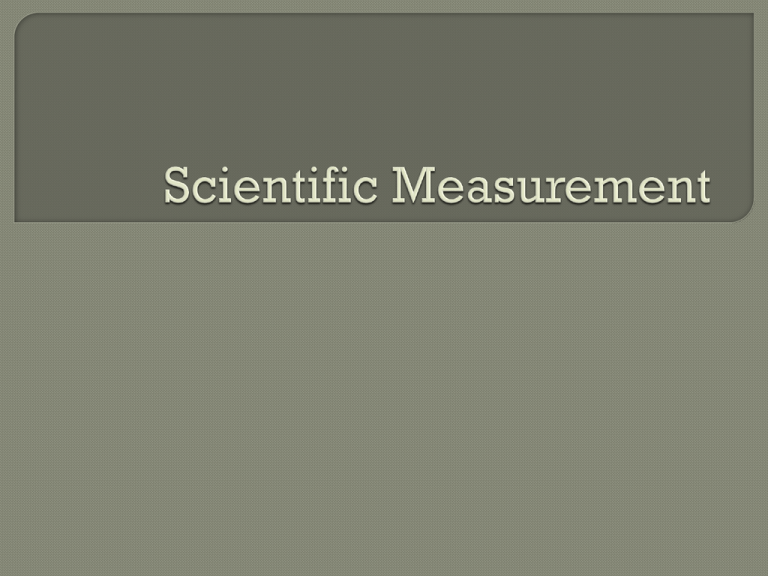
58% 1. 2. Yes No 42% 1 2 Accuracy - How close a measurement is to the true value Precision - How close a set of measurements are to one another. 0% 1. 32% 2. 5% 3. 63% 4. Accurate Precise Both Neither 0% 1. 95% 2. 5% 3. 0% 4. Accurate Precise Both Neither 40% 1. 5% 2. 50% 3. 5% 4. Accurate Precise Both Neither Write each power of ten in standard notation. 100% 3 10 a) 30 b) 100 c) 1000 00 10 0 0% 10 30 0% Write each power of ten in standard notation. 90% 6 10 a) 60 b) 1000000 c) 10000 10% 0 00 10 10 00 60 00 0 0% Write each power of ten in standard notation. 17% 0 .0 1 17% 10 a) .01 b) -20 c) 100 -2 0 -2 10 67% Write each power of ten in standard notation. 100% -4 10 a) -.0004 b) .0004 c) 10000 0 00 10 04 0% .0 0 -.0 00 4 0% Setting the Stage • There are 325,000 grains of sand in a tub. Write that number in scientific notation. What is the exponent to the 10 for 325,000 grains of sand? 53% 0% 47% 0% 0% 0% 0% 1. 2. 3. 4. 5. 6. 7. 3 4 5 6 -6 -5 -4 Definition • Scientific notation- is a compact way of writing numbers with absolute values that are very large or very small. • Glencoe McGraw-Hill. Math connects cours 3. pages 130-131 all numbers are expressed as whole numbers between 1 and 9 multiplied by a whole number power of 10. If the absolute value of the original number was between 0 and 1, the exponent is negative. Otherwise, the exponent is positive. • Ex. 125 = 1.25 x 102 • 0.00004567 = 4.567 x 10-5 7% 1. 87% 2. 0% 3. 0% 4. 7% 5. 0% 6. -6 6 -5 5 4 -4 0% 1. 0% 2. 6% 3. 11% 4. 11% 5. 72% 6. -6 6 -5 5 4 -4 What is 2.85 x 104 written in standard form .000285 285 28500 2850 88% 28 28 50 0 5 50 6% 0% 28 02 85 6% .0 0 A. B. C. D. 7 10 What is 3.085 x written in standard form .0000003085 30,850,000 3085 308,500,000 77% 15% 8% 00 85 30 85 00 0 30 0 00 0 85 30 00 00 30 85 0% .0 0 A. B. C. D. -3 10 What is 1.55 x written in standard form .00155 155 1550 .000155 94% 6% 0% .0 0 01 55 50 15 5 15 15 5 0% .0 0 A. B. C. D. -2 10 What is 2.7005 x written in standard form A. B. C. D. 270.05 27005 .27005 .027005 Write the following numbers in scientific notation: A) 5,000 E) 0.0145 B) 34,000 F) 0.000238 C) 1,230,000 G) 0.0000651 D) 5,050,000,000 H) 0.000000673 Closure / Summary • Explain why 32.8 x 104 is not correctly written in scientific notation. • What does a negative exponent tell you about writing the number in standard form. Significant Figures are used to show the accuracy and precision of the instruments used to take the measurement. 1 0 0% 1. 0% 2. 0% 3. 0% 4. 0.55 0.7 0.6 0.8 1 0 0% 1. 0% 2. 0% 3. 0% 4. 0.55 0.70 0.67 0.65 To show how precise the instrument is: • Read the measurement to one decimal place what the instrument is marked 0% 1. 0% 2. 0% 3. 0% 4. 4.85 7.2 4.3 4.35 0% 1. 0% 2. 0% 3. 0% 4. 17.0 16.8 15.18 15.2 Non-zero digits are always significant 1,2,3,4,5,6,7,8,9 are always significant Rules for Zeros: a) Leading Zeros never count as significant 0.0000456 0.0032 b) Captive zeros (zeros between non-zero digits) are always significant 10,034 0.005008 c) Trailing Zeros are significant ONLY IF there is a decimal in the number. 234,000 234,000.0 0.045600 If we want to write the number 700 with 3 significant digits we can do so using the following two methods: 700. OR 7.00×102 0% 1. 0% 2. 0% 3. 0% 4. 1 2 3 0 0% 1. 0% 2. 0% 3. 0% 4. 0 1 2 3 0% 1. 0% 2. 0% 3. 0% 4. 1 2 21 22 3 3 1 6 7 4 5 6 7 8 9 10 11 12 13 14 15 16 17 18 19 20 0% 1. 0% 2. 0% 3. 0% 4. 1 2 21 22 3 0 1 2 3 4 5 6 7 8 9 10 11 12 13 14 15 16 17 18 19 20 0% 1. 0% 2. 0% 3. 0% 4. 1 2 21 22 3 2 5 1 3 4 5 6 7 8 9 10 11 12 13 14 15 16 17 18 19 20 0% 1. 0% 2. 0% 3. 0% 4. 1 2 21 22 3 1 2 3 4 4 5 6 7 8 9 10 11 12 13 14 15 16 17 18 19 20 0% 1. 0% 2. 0% 3. 0% 4. 1 2 21 22 3 1 2 3 4 4 5 6 7 8 9 10 11 12 13 14 15 16 17 18 19 20 0% 1. 0% 2. 0% 3. 0% 4. 1 2 21 22 3 5 8 2 4 4 5 6 7 8 9 10 11 12 13 14 15 16 17 18 19 20 0% 1. 0% 2. 0% 3. 0% 4. 1 2 21 22 3 5 8 2 4 4 5 6 7 8 9 10 11 12 13 14 15 16 17 18 19 20 0% 1. 0% 2. 0% 3. 0% 4. 1 2 21 22 3 3 8 4 5 4 5 6 7 8 9 10 11 12 13 14 15 16 17 18 19 20 Count (from left to right) how many significant figures you need. Look at the next number to see if you need to round your last sig. fig. up or down. Round the following to 3 sig. figs 1. 1,344 2. 0.00056784 3. 24,500 4. 12,345 5. 2.45678 x 10-3 We have two ways of categorizing sig. fig. calculations: A) Addition and Subtraction B) Multiplication, Division, other math When we add and subtract we are only worried about the number of decimal places involved in the numbers present. We do not care about the number of actual significant digits. We will always pick the number that has the least decimal places. A) 14.0 + 2.45 B) 12 + 7.2 C) 0.00123 + 1.005 D) 100 – 5.8 E) 2.5 – 1.25 F) 43.786 – 32.11 If we are multiplying, dividing, using exponents, trigonometry, calculus, etc we must use the least number of significant digits of the numbers in the set. For example... A) 12 × 5.00 B) 8.45 × 4.3 C) 0.0125 × 7.532 D) 5.6 × 11.7 E) 34.1 × 0.55 F) 119 / 32 G) 756.2 / 29.8 H) 0.976 / 0.0044 I ) 981 / 756.23 J) 43.2 / 12.45 Density – the amount of matter present in a given volume of a substance, the ratio of the mass of an object to its volume. D = mass Volume Celsius Scale – based on the freezing point (0oC) and boiling point (100oC) of water. Kelvin Scale – based on absolute zero (the temperature at which all motion ceases). 1 degree Kelvin is equal to 1 degree Celsius. Fahrenheit Scale – used in US and Great Britain. Degrees are smaller than a Celsius or Kelvin degree. Kelvin/Celsius K = oC + 273 Fahrenheit/Celsius oF = 1.80(oC) + 32 Exact Numbers are counting numbers or defined numbers (such as 2.45 cm = 1 in) - never limit the number of significant figures in a calculation.
